
Features
Operations
Major League Excitement in Wisconsin
AirVenture 2009 has come and gone. In case you missed it, Wings offers this report. Let us first qualify that a full report on all that was new at OSH would take far more space than we have
November 30, 2009 By Fred Petrie
AirVenture 2009 has come and gone. In case you missed it, Wings offers this report. Let us first qualify that a full report on all that was new at OSH would take far more space than we have, so my choice of highlights will miss 90 per cent of what others might select. Apologies – you will just have to go yourself in 2010.
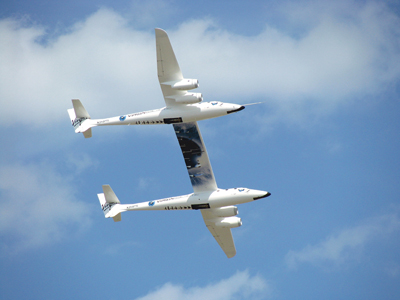 |
|
| WhiteKnightTwo is the quantum leap in space launch platforms that brings us to the dawn of commercial space flight.
|
The mood in 2008 was despondent as the economy was showing signs of stagnation, even before the September collapse of Lehman Brothers. But the mood in 2009 was definitely consistent with Mark Carney’s assertion that the recession is over. EAA was reporting that numbers were up across the board, from advance ticket sales to campground bookings – the North 40 (GA aircraft camping) was full by Monday afternoon.
I have chosen four highlights for my report. The biggest was the visit by the Airbus 380, on the 40th anniversary of the Concorde’s first flight. The most spectacular visitor was White-KnightTwo, or VMS Eve (named for Richard Branson’s mother). Branson himself flew on board for its first public air show. There was strong Canadian participation for the centennial of Canadian flight. Finally, for the boy (or girl) in all of us, there were the latest in toys (the foundation of innovation) from flying road vehicles to electric aircraft.
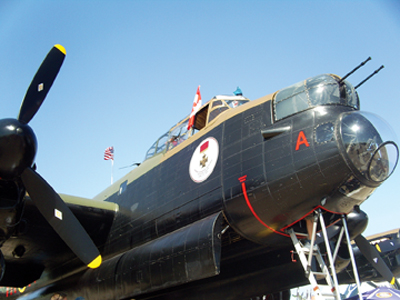 |
|
| The Canadian invasion of AirVenture 2009 included the Canadian Warplane Heritage Museum’s Lancaster.
|
Airbus 380
The Airbus 380 is the world’s largest “passenger” airplane. That qualification is because the Antonov 225 Mriya has a MTOW of 600,000 kg versus the freighter version of the A380 at 590,000 kg. With that quibble aside, the A380 is big.
There are some who quibble over the “biggest” air show as well, trying to compare Oshkosh with Paris or Farnborough – they are simply different, but with the A380 now coming to OSH as well as the others, AirVenture is definitely in the same league, a league it has surely been in since Concorde began its regular visits in 1985. This was Airbus’ second appearance at OSH since it brought its A300 “Beluga” to celebrate the 2003 centennial of flight (at 1400 m3 interior space, it was only slightly smaller than the A380’s 1,570 m3. The Airbus 380 is also defined by its big numbers: 280,000 lbs of thrust powering 1.2 million lbs. But most impressive to me was watching its slow pass; at some 30 degrees of pitch, it seemed to be standing still, and certain to fall out of the sky at any second, then it added power and smoothly climbed out.
WhiteKnightTwo
It was only in 2005 that WhiteKnight brought SpaceShipOne to OSH after claiming the Ansari X-prize. That year Richard Branson announced the formation of Virgin Galactic and ordered Rutan’s Scaled Composites to build him WhiteKnightTwo (WK2) and SpaceShipTwo for a fledging space tourism business (even at $200,000 a pop, it was a giant step down from $20 million for a Soyuz ride). Only four years later, WhiteKnightTwo arrived for its first public outing.
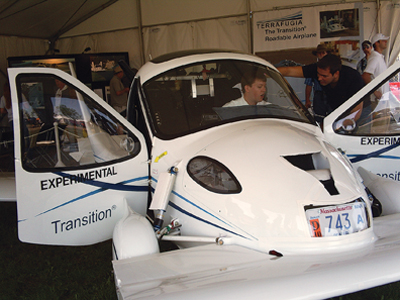 |
|
| The Terrafugia Transition first flew last March.
|
It is three times the size of its predecessor and radically different, with a twin fuselage configuration (flown from the starboard one, the other one is space for a flying lab). WK2 is powered by four Pratt & Whitney 308A high bypass ratio turbofans that are very quiet in flight. At a 140-foot wingspan, it is by far the largest all-composite aircraft ever built. Sir Richard always has another announcement. For 2009, it was the signing with Shiek Muhammad al Husseini (of Abu Dhabi) of a new joint venture for commercial launch of low-altitude satellites using WK2 (I guess even Sir Richard likes to spread the risk of the space business).
WK2 is the quantum leap in space launch platforms that brings us to the dawn of commercial space flight. I asked Virgin Galactic’s president Will Whitehorn what event he could foresee as marking the moment of sunrise. He suggested either the first paying space tourist or the first launch of a space payload from WK2, either event on tap for a year or two away. But the highest compliment for Rutan/Branson and company was an interview of Tom Poberezny, longtime EAA chairman, where he was asked, “if you could fly any aircraft coming to AirVenture …” and his answer was “WhiteKnightTwo.”
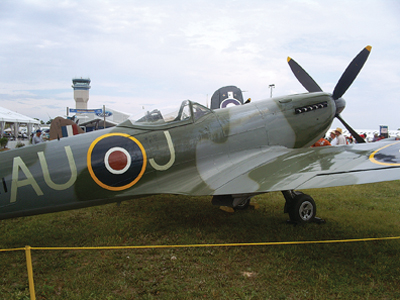 |
|
| Michael Potter’s Vintage Wings of Canada brought three of its war birds to OSH, a Spitfire (above), a Hurricane and a Corsair.
|
Canada at OSH
The Canadian invasion of AirVenture 2009 included the Canadian Warplane Heritage Museum’s Lancaster, a Silver Dart replica and three specimens from Vintage Wings. EAA Canada’s Ed Lubitz had brought the Silver Dart Group’s replica to the federal pavilion; it was a special treat, after a detailed briefing, to wend my way to the controls for a picture. Michael Potter’s Vintage Wings of Canada brought three of its war birds to OSH: a Spitfire, a Hurricane and a Corsair. The Lancaster had a prominent position on Aeroshell Square; a personal memory was sheltering from a thunderstorm in the Lanc’s bomb bay and chatting with a Brit visitor whose father had been a Lanc pilot (followed by a career with BOAC), comparing notes about my namesake uncle, a flight engineer with Canada’s 405 Pathfinder squadron. A special treat was the presentation of “Billy Bishop Goes to War” in the Eagle Hangar of the EAA Museum. I was afraid of being disappointed, comparing it to the original with Eric Peterson, but David Cecsarini of Milwaukee’s Next Act Theatre Company did a great job of bringing this chapter of Canada’s aviation heritage to life.
Canada was well represented on the commercial front as well. I especially liked the huge Diamond exhibit with its full line from the DA20 to the D-Jet. I compared it to the other single-engine developments – Cirrus’ Vision and the Piper Jet. I liked the lines of the D-Jet. It just looked more real, not to mention, sleeker, than the over-the-fuselage engine placement on the others.
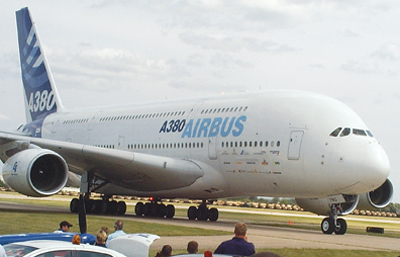 |
|
| With the A380 now coming to OSH as well as the others, AirVenture is definitely in the same league as Paris and Farnborough.
|
The attendance at AirVenture 2009 was announced at 578,000, up 12 per cent over 2008. There were more than 10,000 aircraft arrivals, including 2,652 show planes, 1,023 homebuilts, 1,007 vintage, 355 war birds, 750 commercial
exhibitors, and 2,182 international visitors, with an estimated 41,000 campers (a couple of years I have left the tent at home and literally slept under the wing, the best way to see Oshkosh). But more important than positive numbers was the spirit on exhibit – COPA’s Kevin Psutka and EAA Canada’s Jack Dueck meeting with AOPA’s Craig Fuller and EAA’s Tom Poberezny and pledging to promote general aviation in all respects, most importantly with education and youth, in events such as the first Learn to Fly day planned for May 2010. Aviation can sometimes be a discouraging business. If you find you need a “fix,” head to Oshkosh July 24-31, 2010.
Innovation at OSH
“Toys for Boys” (and girls, of course) is always a fantasy treat at Oshkosh. This report has chosen three developments: go anywhere, aircraft for the road, and the latest in electric aircraft.
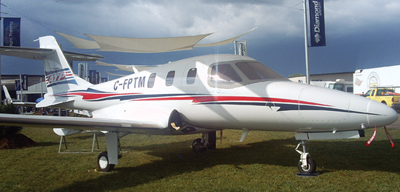 |
|
| Diamond exhibited its full line from the DA20 to the D-Jet (shown here).
|
Going anywhere in a personal aircraft means landing anywhere. With the world being mostly water, that means being an amphibian. Most aircraft designed for water as well as flight have shared a certain awkward look. But the ICON A5 has got to be the sexiest toy of late, designed specifically for the Light Sport Aircraft Rule. For the camper, it is hard to beat the Sportsman by Glasair with all options from amphibs to tundra tires. With the “Two weeks to taxi” build program, anyone can build one during their next vacation. With up to 210-horsepower engine options, performance is fantastic whether in climb or cruise. The wings fold and you can trailer it home.
Which brings us to flying cars that you can drive to the airport, or land when weather goes down and continue the trip on the highway. The Taylor Aerocar was flown in 1949 and certified by 1956, but only half of the 500 orders needed to put it into production were obtained, so only six were ever built (one still flying with the Kissimmee Air Museum).
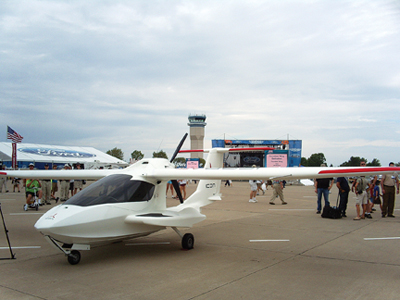 |
|
| The ICON A5 has got to be the sexiest toy of late, designed specifically for the Light Sport Aircraft Rule.
|
Somewhat similar, the Terra-fugia Transition first flew last March. Its folding wings can convert it from a plane to a car in 30 seconds (versus the five minutes the Aerocar required). It is also designed to fit into the Light Sport Aircraft Rule. With the second beta version under construction to continue the flight test program for possible flight display at OSH 2010, it is still targeting 2011 production. More recently, the Samson Motors Switchblade was unveiled. Still some way from a prototype, its unique design has the wings folding forward, tucking under the fuselage like a switchblade knife. Its innovative feature is that it meets road standards for a motorcycle, being a trike, even though it is two-seat, side-by-side, fully enclosed. It also scores high in the sleek looks department.
The electric airplane pioneer was Randall Fishman, who flew his single-seat Electro-flyer C to OSH last year. His two-seat prototype Electroflyer X was on display and a test flight, by the time you read this report, should have already been completed. Kit manufacturer Sonex Aircraft, based at Oshkosh, is continuing its Waiex electric aircraft program. Meanwhile, Tom Peghiny, the principal of CT USA, had built an electric version of his Spyder ultralight that he was flying at OSH. He had met the revolutionary Yuneec electric engine at the Friedrichshafen show last spring and bought one. Which brings us to the Yuneec e430 two-place LSA. I had a chat with Yuneec International Managing Director Clive Coote back at their display after the press conference. Coote explained that his background, and his relationship with Yuneec of China, was in model aircraft. I was surprised to learn that electric power has largely taken over from gas engines for model aircraft. With the advancements in UAVs, some see the day of pilotless flight. The e430 is effectively a model aircraft with a pilot (and passenger)! Such innovation is fascinating and what Oshkosh is all about. Its three-unit lithium polymer batteries drive its 40-kilowatt (54-horsepower) engine in virtually vibration-free silence. This e430 was built in a few months (since the decision was taken at Friedrichshafen), test flown, crated for shipment to California, and flown off its 25 hours proving flights so it could be exhibited at Oshkosh.
Coote predicted being back at AirVenture 2010 with a solar-cell-topped wing for recharging in flight for extended range. Indeed, pioneer Eric Raymond recently toured his Sunseeker motorglider around Europe, solar charging in flight.
A final related highlight was the panel on the future of aviation fuels. Despite all the talk about auto fuel conversions, diesels with Jet A and biofuels, AirVenture Today reported “No ‘magic bullet’ to replace 100 LL.” Perhaps as the technology of batteries, or fuel cells, continues exponentially, we could all be flying electric aircraft in the not too distant future. At least its promise means we may still be flying!